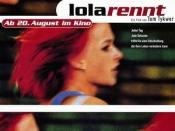In the right place at the wrong timeRun Lola Run EssayThe essence of postmodern media is its relevance to current events and modern issues. One of the most significant issues is the chaotic lifestyle of civilization due to the lack of time. The film Run Lola Run confronts the subject that slight variations in time are able to bring about vast differences in the outcome of one's life. In the film the protagonist Lola must take part in a frantic journey were she has twenty minutes to find 100 000 Deutschmarks if she is to save the life of Manni, her boyfriend who lost the money which was picked up by a homeless person on the subway. Manni has until noon to get the money to his boss or he will be murdered. Lola runs through the streets of Berlin attempting to find the money. During this journey, the viewer encounters the significance a minuscule time variation in Lola's action will have on the outcome of every individual in the film.
The director Tom Tyker was able to conquer this feat by utilizing the fragmentation elements of, symbolism, irony, and specified filming/editing techniques.
Throughout Lola's journey, the director uses certain recurring symbols to give the viewers a better understanding of the character's feelings, conflicts, and reasoning. The most prominent symbols are the dominance of the colour red, The significance placed upon spirals, and the music. The colour red represents danger and stress, in the film it is utilized to display the stranglehold time holds on humanity. The root of Lola's conflict in the film is initiated by the red telephone that she receives Manni's hysterical cry for help from. Another use of the colour red is Lola's hair, by the director choosing to have Lola possess bright red hair it clearly displays the desperation and fear that Lola encounters. At the conclusion of plot one (1) there is a flashback to a discussion between Manni and Lola were Lola questions Manni's love for her, this conversation is filled in a room with a red ambiance. During this conversation, Lola is unsure that Manni is truly her soul mate, which adds to her subconscious question of what depths she should reach to help Manni out of his downfall. The color red appears whenever a character is introduced to an unpleasant situation whether it is Lola discovering Manni's situation through the phone call or Lola questioning Manni's love for her when her love for him causes her own demise. While the color red represents a conflict, the characters will face; the symbol of a spiral is used in the film to represent confusion. A Spiral appears in scenes were a character is unsure of the circumstances surrounding them. When Lola is informed of Manni's situation, she travels down a set of spiral stairs, the alteration in the time it takes for her to get to the bottom of the stairs effect the outcome of her entire journey. A spiral will always end at a certain point by Lola altering the time it takes her to travel down the spiral stairs it is as if she is entering a new spiral, which subsequently leads to a completely different final point or outcome. The other scene were the significance on spirals is placed is when Manni is first calling Lola he is standing outside of a Cafe which is clearly named the "spiral cafe". At this point in the film Manni has become delusion with fear and has entered a downward spiral that will lead to failure if Lola is once again late. In plot one Lola arrives late not phasing the downward spiral that Manni is become prisoner to so they rob the grocery store and Lola is murdered. While in Plot three Manni comes across the homeless person who found the money leaving the spiral of Lola's death and entering the path of their success. The director's usage of spirals clearly demonstrates that a differential in time will lead to a different destiny for the individual. The recurrence of the clock in the film is the most simplicit and concise symbol. Throughout Lola's adventure, she must always take note of the time in order to achieve her goal. The goal appears at all pivotal times in the movie; at the beginning of the movie to signify the start of Lola's journey, after she does not receive money from her father, and prior to her encounter with Manni. The clock is utilized to bring the viewer into the action of the film it enables to share the increase in desperation and excitement as time diminishes. The relation that the appearance of clocks shares with the difference a second can make is that in each plot the clock will appear at a different time in stride with the events of the plot. For example when Lola asks the old lady for the time in the first plot she stops and speaks to her which consequently leads to her not meeting Manni in time. While in the third plot she asks the old lady for the time around the block of her father's building signifying that she is further ahead in time. The symbols found in the movie are cleverly placed and filmed in a certain manner to intensify the viewer's relationship to the characters and consistently remind them of the importance of time.
Irony is a literary device used to grasp the reader's attention by taking preposterous events and having them influence each other. Through the usage of irony, the influences of time can clearly be identified. In the film Lola is not your average protagonist, she is a follower of existentialism living her life as though her actions effect no one accept herself. The irony of her personality is that in the film her actions altered by a split second in time change the outcome of hundreds of individuals. The irony such as Manny being struck by the ambulance, which is meant to give life, not take it is such a ridiculous situation it creates a lasting impact in your mind. It stimulates the viewer to realize in this plot The ambulance wasn't slowed down by Lola so her two second interaction with the driver would have saved Manni's life. Towards the conclusion of plot one after Lola has helped Manni rob the grocery store the backround music is playing a song that stats, "what a difference a day can make." The irony of the song is that if Lola had gotten to Manni not a day earlier but a minute earlier they could have avoided the whole situation. The irony found in the film may appear on the outskirts to be utilized as dark humour although the true reason the majority of the significant events in the plot are ironic is to create a lasting impression on the viewer.
For the movie Run Lola Run the director decided to use a unique filming technique, this technique was to have three similar plots with three different conclusions. The director's choice to do this was to glorify the difference a change in time could cause. By having three (3) coexisting plots the viewer is able to understand the repercussions of Lola's time management. All three plots follow a similar path of Lola first receiving a distress call from Manni, then her running down the spiral stairs, asking her father for the money, and a frantic conclusion of trying to reach Manni in time. The key to the significance placed upon time is that the slightest change in the time it takes Lola to get to the bottom of the spiral stairs creates a domino effect altering every character's future. In the first plot Lola is slower to get down the stairs because she is frightened by a dog, this one-second delay creates a certain destiny for each character such as the old woman losing her child-to-child services. In Lola's case this delay causes her not to receive money from her father, find out her father is not biological, and being late to meet up with Manni. This results in Manni going to rob the grocery store and in turn Lola's death. While in the second plot, Lola is tripped by the owner of the dog while going down the stairs causing her to be at her slowest pace of the film. This slight delay causes Lola to not ask the ambulance for a ride, not forcing it to stop for the people with the glass, which in turn leads to Manni's death. In addition, when she encounters the old woman the one-second daily changed the woman's destiny to winning the lottery. In the third plot, Lola avoids the dog and the owner by hurdling over them therefore getting down the stairs in the shortest period. This advance in time caused the bum to purchase the stolen bicycle causing him to cross paths with Manni, enabling Manni to give the money to his boss. Lola's success also affected the old women because in this plot she becomes a very religious individual. Lola's slight change in the time it takes her to get down the stairs substantially changes the future of all the characters' (not to describe because change is clear so it would become redundant). The director specifically made the changes in the plot extravagant to permeate the difference a second can make into the minds of the viewers.
The greatest attribute of the film Run Lola Run is that it is the tale of one's struggle to control time and that their behaviour in certain periods will affect the events of the future. The exquisiteness in this topic is that every individual can relate to having the antagonist of the film being time. The power that time possesses is clearly established throughout the film by the usage of the multiple plot scenario and the more hidden messages found through symbolism and irony. There is a saying that one can be at the right place at the wrong time this statement has never been more true than that in the events of the film. The events of the film may appear exuberant and fictional although the theme that a second can make all the difference could not be any more real, whether it be in sports or any component of life, time will always be the enemy of the masses.
âÂÂWorks citedRun Lola Run. Dir. Tom Tyker. Perf. Franka Potente. X-Filme Creative Pool, 1999. DVD.





